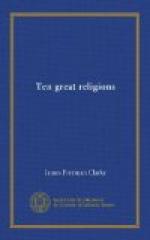For many years after the publication of the Avesta its genuineness and authenticity were a matter of dispute among the learned men of Europe; Sir William Jones especially denying it to be an ancient work, or the production of Zoroaster. But almost all modern writers of eminence now admit both. Already in 1826 Heeren said that these books had “stood the fiery ordeal of criticism.” “Few remains of antiquity,” he remarks, “have undergone such attentive examination as the books of the Zend Avesta. This criticism has turned out to their advantage; the genuineness of the principal compositions, especially of the Vendidad and Izeschne (Yacna), has been demonstrated; and we may consider as completely ascertained all that regards the rank of each book of the Zend Avesta.”
Rhode (one of the first of scholars of his day in this department) says: “There is not the least doubt that these are the books ascribed in the most ancient times to Zoroaster.” Of the Vendidad he says: “It has both the inward and outward marks of the highest antiquity, so that we fear not to say that only prejudice or ignorance could doubt it[119].”
Sec. 4. Epoch of Zoroaster. What do we know of him?
As to the age of these books, however, and the period at which Zoroaster lived, there is the greatest difference of opinion. He is mentioned by Plato (Alcibiades, I. 37), who speaks of “the magic (or religious doctrines) of Zoroaster the Ormazdian” (magedan Zoroastran ton Oromazon[120]). As Plato speaks of his religion as something established in the form of Magism, or the system of the Medes, in West Iran, while the Avesta appears to have originated in Bactria, or East Iran[121], this already carries the age of Zoroaster back to at least the sixth or seventh century before Christ. When the Avesta was written, Bactria was an independent monarchy. Zoroaster is represented as teaching under King Vistacpa. But the Assyrians conquered Bactria B.C. 1200, which was the last of the Iranic kingdoms, they having previously vanquished the Medes, Hyrcanians, Parthians, Persians, etc. As Zoroaster must have lived before this conquest, his period is taken back to a still more remote time, about B.C. 1300 or B.C. 1250[122] It is difficult to be more precise than this. Bunsen indeed[123] suggests that “the date of Zoroaster, as fixed by Aristotle, cannot be said to be so very irrational. He and Eudoxus, according to Pliny, place him six thousand years before the death of Plato; Hermippus, five thousand years before the Trojan war,” or about B.C. 6300 or B.C. 6350. But Bunsen adds: “At the present stage of the inquiry the question whether this date is set too high cannot be answered either in the negative or affirmative.” Spiegel, in one of his latest works,[124] considers Zoroaster as a neighbor and contemporary of Abraham, therefore as living B.C. 2000 instead of B.C. 6350. Professor Whitney of New Haven places the epoch of Zoroaster at “least B.C. 1000,” and adds




